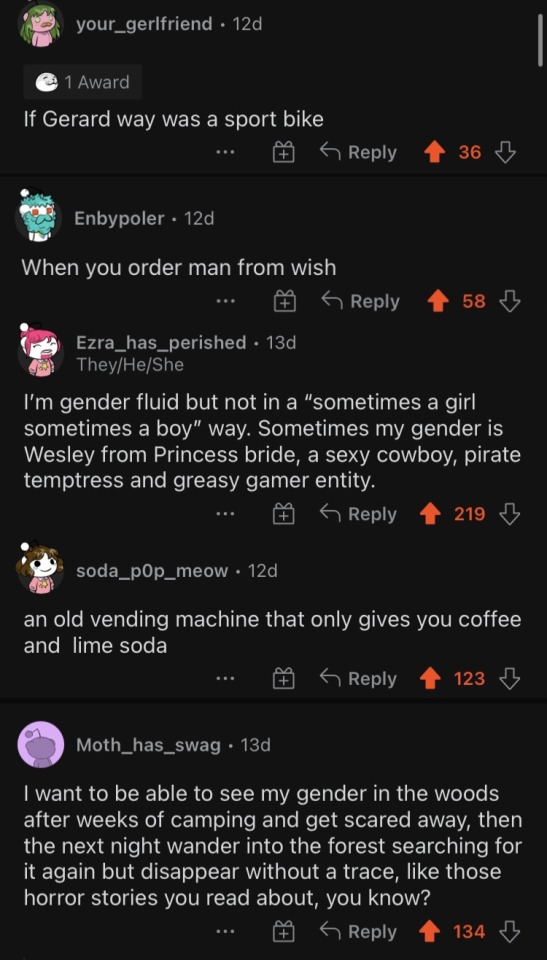Nintendo…why Wont You Let Me Walk Within Three Feet Of This Man
Nintendo…why wont you let me walk within three feet of this man
More Posts from Anniespongebob and Others
“For some time, Hollywood has marketed family entertainment according to a two-pronged strategy, with cute stuff and kinetic motion for the kids and sly pop-cultural references and tame double entendres for mom and dad. Miyazaki has no interest in such trickery, or in the alternative method, most successfully deployed in Pixar features like Finding Nemo, Toy Story 3 and Inside/Out, of blending silliness with sentimentality.”


“Most films made for children are flashy adventure-comedies. Structurally and tonally, they feel almost exactly like blockbusters made for adults, scrubbed of any potentially offensive material. They aren’t so much made for children as they’re made to be not not for children. It’s perhaps telling that the genre is generally called “Family,” rather than “Children’s.” The films are designed to be pleasing to a broad, age-diverse audience, but they’re not necessarily specially made for young minds.”

“My Neighbor Totoro, on the other hand, is a genuine children’s film, attuned to child psychology. Satsuki and Mei move and speak like children: they run and romp, giggle and yell. The sibling dynamic is sensitively rendered: Satsuki is eager to impress her parents but sometimes succumbs to silliness, while Mei is Satsuki’s shadow and echo (with an independent streak). But perhaps most uniquely, My Neighbor Totoro follows children’s goals and concerns. Its protagonists aren’t given a mission or a call to adventure - in the absence of a larger drama, they create their own, as children in stable environments do. They play.”

“Consider the sequence just before Mei first encounters Totoro. Satsuki has left for school, and Dad is working from home, so Mei dons a hat and a shoulder bag and tells her father that she’s “off to run some errands” - The film is hers for the next ten minutes, with very little dialogue. She’s seized by ideas, and then abandons them; her goals switch from moment to moment. First she wants to play “flower shop” with her dad, but then she becomes distracted by a pool full of tadpoles. Then, of course, she needs a bucket to catch tadpoles in - but the bucket has a hole in it. And on it goes, but we’re never bored, because Mei is never bored.”




“[…] You can only ride a ride so many times before the thrill wears off. But a child can never exhaust the possibilities of a park or a neighborhood or a forest, and Totoro exists in this mode. The film is made up of travel and transit and exploration, set against lush, evocative landscapes that seem to extend far beyond the frame. We enter the film driving along a dirt road past houses and rice paddies; we follow Mei as she clambers through a thicket and into the forest; we walk home from school with the girls, ducking into a shrine to take shelter from the rain; we run past endless green fields with Satsuki as she searches for Mei. The psychic center of Totoro’s world is an impossibly giant camphor tree covered in moss. The girls climb over it, bow to it as a forest-guardian, and at one point fly high above it, with the help of Totoro. Much like Totoro himself, the tree is enormous and initially intimidating, but ultimately a source of shelter and inspiration.”

“My Neighbor Totoro has a story, but it’s the kind of story that a child might make up, or that a parent might tell as a bedtime story, prodded along by the refrain, “And then what happened?” This kind of whimsicality is actually baked into Miyazaki’s process: he begins animating his films before they’re fully written. Totoro has chase scenes and fantastical creatures, but these are flights of fancy rooted in a familiar world. A big part of being a kid is watching and waiting, and Miyazaki understands this. When Mei catches a glimpse of a small Totoro running under her house, she crouches down and stares into the gap, waiting. Miyazaki holds on this image: we wait with her. Magical things happen, but most of life happens in between those things—and there is a kind of gentle magic, for a child, in seeing those in-betweens brought to life truthfully on screen.”


A.O. Scott and Lauren Wilford on “My Neighbor Totoro”, 2017.
What if Sakumo had a twin brother? (Might be named Raiden :3)
And what if that brother was just a little bit overprotective of his much nicer twin.

He might not take too kindly to people talking shit about his brother after that failed mission. Might even get a bit stabby about it.

And while Sakumo appreciates the sentiment, killing anyone who so much as looks at him funny doesn't solve the problem.
Raiden begs to differ.
So I asked nonbinary reddit this a while back:

And they really went all out, here are some of my favorite responses:





And of course, the most confusing of all to cis people:

Link to the original if you wanna see more responses!


Fan art of a fan fic
Kamui Blues by @butter--peanut










Oh no:(((😔😔😔😔 Gai was going to HUG HIM it looks like….Kakashi’s fucked UP and he knows it his face in the last frame he just looks tired I can’t I can’t my poor baby BOY😭😔😞 I just have to remember later we see Gai grab his leg and touch his hair and Kakashi doesn’t react like the growth…but rn…oof☹️😣




yeah ok. tbh this is actually just me talking abt my own experiences with my older cousins LMAO
edit: cont



i think i drew this as fast as i could lmao

~accurate representation of team 7 lmAo



his butt says naruto






Someone's talking malicious shit about Sakumo and attempting to put him out of business. Good thing Sakumo's gym buddy is the world's greatest medic corporate lawyer.
This puts Shizune and Kakashi in each other's orbit.
It is very cute.
Tsunade and Sakumo are too busy crying over how cute it is to realise their two kids are plotting to take over the corporate world.
(Idea for medics being lawyers in business AU comes from Doodlebotbop on AO3.)
-
 definitelyimportantpost reblogged this · 2 weeks ago
definitelyimportantpost reblogged this · 2 weeks ago -
 lepidopteralarva reblogged this · 2 weeks ago
lepidopteralarva reblogged this · 2 weeks ago -
 goldoans liked this · 2 weeks ago
goldoans liked this · 2 weeks ago -
 tunkus reblogged this · 2 weeks ago
tunkus reblogged this · 2 weeks ago -
 tunkus liked this · 2 weeks ago
tunkus liked this · 2 weeks ago -
 lepospondyl reblogged this · 2 weeks ago
lepospondyl reblogged this · 2 weeks ago -
 lepospondyl liked this · 2 weeks ago
lepospondyl liked this · 2 weeks ago -
 purgknight reblogged this · 2 weeks ago
purgknight reblogged this · 2 weeks ago -
 apples-of-apples reblogged this · 2 weeks ago
apples-of-apples reblogged this · 2 weeks ago -
 michuzurek01 reblogged this · 2 weeks ago
michuzurek01 reblogged this · 2 weeks ago -
 maxineprimal reblogged this · 1 month ago
maxineprimal reblogged this · 1 month ago -
 herehaveafandom reblogged this · 3 months ago
herehaveafandom reblogged this · 3 months ago -
 sick-dicks reblogged this · 4 months ago
sick-dicks reblogged this · 4 months ago -
 robynkittyblogs reblogged this · 4 months ago
robynkittyblogs reblogged this · 4 months ago -
 dearlybeloved-dreameater liked this · 4 months ago
dearlybeloved-dreameater liked this · 4 months ago -
 strawberrycatworld reblogged this · 5 months ago
strawberrycatworld reblogged this · 5 months ago -
 strawberrycatworld liked this · 5 months ago
strawberrycatworld liked this · 5 months ago -
 ohmewhatsthis reblogged this · 5 months ago
ohmewhatsthis reblogged this · 5 months ago -
 kandicon reblogged this · 5 months ago
kandicon reblogged this · 5 months ago -
 kandicon liked this · 5 months ago
kandicon liked this · 5 months ago -
 joshurequiem liked this · 6 months ago
joshurequiem liked this · 6 months ago -
 krisiverse liked this · 6 months ago
krisiverse liked this · 6 months ago -
 theoryfan205 reblogged this · 6 months ago
theoryfan205 reblogged this · 6 months ago -
 innovative-detritus reblogged this · 6 months ago
innovative-detritus reblogged this · 6 months ago -
 detectivewebs liked this · 6 months ago
detectivewebs liked this · 6 months ago -
 little-lanterns reblogged this · 7 months ago
little-lanterns reblogged this · 7 months ago -
 totallynotafishthatdbesilly liked this · 7 months ago
totallynotafishthatdbesilly liked this · 7 months ago -
 imnothereyet reblogged this · 7 months ago
imnothereyet reblogged this · 7 months ago -
 thisinhumanplace liked this · 7 months ago
thisinhumanplace liked this · 7 months ago -
 christhetree256 liked this · 7 months ago
christhetree256 liked this · 7 months ago -
 kinsey3furry300 reblogged this · 7 months ago
kinsey3furry300 reblogged this · 7 months ago -
 kinsey3furry300 liked this · 7 months ago
kinsey3furry300 liked this · 7 months ago -
 legendary-pancakes liked this · 7 months ago
legendary-pancakes liked this · 7 months ago -
 pikaboops reblogged this · 7 months ago
pikaboops reblogged this · 7 months ago -
 technicality-the-nonexistant liked this · 7 months ago
technicality-the-nonexistant liked this · 7 months ago -
 cellularrespirationidk liked this · 7 months ago
cellularrespirationidk liked this · 7 months ago -
 rememberrymainblog liked this · 7 months ago
rememberrymainblog liked this · 7 months ago -
 milesofpilesofmoss reblogged this · 7 months ago
milesofpilesofmoss reblogged this · 7 months ago -
 milesofpilesofmoss liked this · 7 months ago
milesofpilesofmoss liked this · 7 months ago -
 cooloak reblogged this · 7 months ago
cooloak reblogged this · 7 months ago -
 the-golden-tip liked this · 7 months ago
the-golden-tip liked this · 7 months ago -
 justanotherrandommoth liked this · 7 months ago
justanotherrandommoth liked this · 7 months ago -
 mossycorvid reblogged this · 7 months ago
mossycorvid reblogged this · 7 months ago -
 vipp-vop liked this · 7 months ago
vipp-vop liked this · 7 months ago -
 legit-nobody-at-all liked this · 7 months ago
legit-nobody-at-all liked this · 7 months ago -
 cutest-silly-nb reblogged this · 7 months ago
cutest-silly-nb reblogged this · 7 months ago -
 cicada-days-of-summer reblogged this · 7 months ago
cicada-days-of-summer reblogged this · 7 months ago -
 cicada-days-of-summer liked this · 7 months ago
cicada-days-of-summer liked this · 7 months ago -
 lucky-brown-cat reblogged this · 7 months ago
lucky-brown-cat reblogged this · 7 months ago -
 lucky-brown-cat liked this · 7 months ago
lucky-brown-cat liked this · 7 months ago